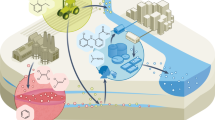Abstract
The application of compound-specific stable isotope analysis (CSIA) was evaluated to characterise a complex groundwater contamination. For this purpose, δ13C and δ2H analysis of benzenes and alkylated derivatives were used to interpret both the impact of different sources on a contaminant plume and the presence of degradation processes. The different contaminant sources could be distinguished based on their combined δ13C–δ2H signature of the benzene, toluene, ethylbenzene and xylenes (BTEX) dissolved in the groundwater. Despite this source differentiation, plume characterisation was not possible due to the complex mixing of the respective contaminant plumes. Furthermore, the original isotope signatures of the sources were not preserved across these plumes. To estimate the level of in situ biodegradation independently from concentration data, the Rayleigh equation was used. Although current literature identifies the application of CSIA as very promising in the frame of characterising organic groundwater pollution, this study has indicated that this approach can be limited with respect to successfully distinguish the different plumes and their relation to the known source zones.







Similar content being viewed by others
References
Abe Y, Hunkeler D (2006) Does the Rayleigh equation apply to evaluate field isotope data in contaminant Hydrology. Environ Sci Technol 40:1588–1596
Ahad JME, Sherwood Lollar B, Edwards EA, Slater GF, Sleep BE (2000) Carbon isotope fractionation during anaerobic biodegradation of toluene: implications for intrinsic bioremediation. Environ Sci Technol 34:892–896
Baltussen E, Sandra P, David F, Cramers C (1999) Stir bar sorptive extraction (SBSE), a novel extraction technique for aqueous samples: theory and principles. J Microcol Sep 11:737–747
Brand WA (1996) High precision isotope ratio monitoring techniques in mass spectrometry. J Mass Spectrom 31:225–235
Dempster HS, Sherwood Lollar B, Feenstra S (1997) Tracing organic contaminants in groundwater: a new methodology using compound-specific isotopic analysis. Environ Sci Technol 31:3193–3197
Fisher A, Bauer J, Meckenstock RU, Stichler W, Griebler C, Maloszewski P, Kastner M, Richnow HH (2006) A multitracer test proving the reliability of Rayleigh equation-based approach for assessing biodegradation in a BTEX contaminated aquifer. Environ Sci Technol 40:4245–4252
Griebler C, Safinowski M, Vieth A, Richnow HH, Meckenstock RU (2004) Combined application of stable carbon isotope analysis and specific metabolites determination for assessing in situ degradation of aromatic hydrocarbons in a tar oil-contaminated aquifer. Environ Sci Technol 38:617–631
Harrington RR, Poulson SR, Drever JI, Colberg PJS, Kelly EF (1999) Carbon isotope systematics of monoaromatic hydrocarbons: vaporization and adsorption experiments. Org Geochem 30:765–775
Hofstetter TB, Berg M (2011) Assessing transformation processes of organic contaminants by compound-specific stable isotope analysis. Trends Anal Chem 30:618–627
Hunkeler D, Andersen N, Aravena R, Bernasconi M, Butler BJ (2001) Hydrogen and carbon isotope fractionation during aerobic biodegradation of benzene. Environ Sci Technol 35:3462–3467
Hunkeler D, Meckenstock RU, Sherwood Lollar B, Schmidt TC, Wilson JT (2008) A guide for assessing biodegradation and source identification of organic ground water contaminants using compound specific isotope analysis. EPA publication EPA 600/R-08/148
Kopinke FD, Georgi A, Voskamp M, Richnow HH (2005) Carbon isotope fractionation of organic contaminants due to retardation on humic substances: implications for natural attenuation studies in aquifers. Environ Sci Technol 39:6052–6062
Mancini SA, Ulrich AC, Lacrampe-Couloume G, Sleep B, Edwards EA, Sherwood Lollar B (2003) Carbon and hydrogen isotopic fractionation during anaerobic biodegradation of Benzene. Appl Environ Microbiol 69:191–198
Mariotti A, Germon JC, Hubert P, Kaiser P, Letolle R, Tardieux RA, Tardieux P (1981) Experimental determination of nitrogen kinetic isotope fractionation: some principles; illustration for the denitrification and nitrification processes. Plant Soil 62:413–430
Marjorie AC, Hunkeler D, Hohener P, Aravena R (eds) (2009) Environmental isotopes in biodegradation and bioremediation. CRC Press, USA
Meckenstock RU, Morasch B, Warthmann R, Schink B, Annweiler E, Michaelis W, Richnow H (1999) 13C/12C isotope fractionation of aromatic hydrocarbons during microbial degradation. Environ Microbiol 1:409–414
Meckenstock RU, Morasch B, Griebler C, Richnow HH (2004) Stable isotope fractionation analysis as a tool to monitor biodegradation in contaminated aquifers. J Contam Hydrol 75:215–255
Meier-Augenstein W (1996) Applied gas chromatography coupled to isotope ratio mass spectrometry. J Chromatogr A 842:351–371
Morasch B, Richnow HH, Schink B, Meckenstock RU (2001) Stable hydrogen and carbon isotope fractionation during microbial toluene degradation: mechanistic and environmental aspects. Appl Environ Microbiol 67:4842–4849
Morasch B, Richnow HH, Schink B, Meckenstock RU (2004) Stable isotope fractionation caused by glycyl radical enzymes during bacterial degradation of aromatic compounds. Appl Environ Microbiol 70:2935–2940
Slater GF (2003) Stable isotope forensics–when isotopes work. Environ Forensics 4:13–23
Slater GF, Ahad JME, Sherwood Lollar B, Allen-King R, Sleep B (2000) Carbon isotope effects resulting from equilibrium sorption of dissolved VOCs. Anal Chem 72:5669–5672
Steinbach A, Seifert R, Annweiler E, Michaelis W (2004) Hydrogen and carbon isotope fractionation during anaerobic biodegradation of aromatic hydrocarbons—a field study. Environ Sci Technol 38:609–616
Van Breukelen BM (2007) Quantifiying the degradation and dilution contribution to natural attenuation of contaminants by means of an open system Rayleigh equation. Environm Sci Technol 41(14):4980–4985
Wang Z, Fingas M, Page DS (1999) Oil spill identification. J Chromatogr A 843:369–411
Wiedemeier TH, Newell CJ, Rifai HS, Wilson JT (eds) (1999) Natural attenuation of fuels and chlorinated solvents in the subsurface. John Wiley & Sons, New York
Wilkes H, Boreham C, Harns G, Zengler K, Rabus R (2000) Anaerobic degradation and carbon isotopic fractionation of alkylbenzenes in crude oil by sulphate-reducing bacteria. Org Geochem 31:101–115
Author information
Authors and Affiliations
Corresponding author
Rights and permissions
About this article
Cite this article
Van Keer, I., Bronders, J., Verhack, J. et al. Limitations in the use of compound-specific stable isotope analysis to understand the behaviour of a complex BTEX groundwater contamination near Brussels (Belgium). Environ Earth Sci 66, 457–470 (2012). https://doi.org/10.1007/s12665-011-1254-y
Received:
Accepted:
Published:
Issue Date:
DOI: https://doi.org/10.1007/s12665-011-1254-y




